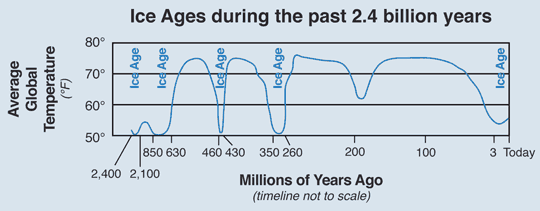12.4 Climate Change in Earth’s History
For the past two centuries, the climate has been relatively stable. People placed their farms and cities in locations that were in a favorable climate without thinking that the climate could change. However, the climate has changed throughout Earth’s history, and a stable climate is not the norm. In recent years, Earth’s climate has begun to change again due to human activities that release greenhouse gases into the atmosphere. The effects of warming are already being seen and will become more extreme as temperature rise.

Climate has changed throughout Earth’s history. Much of the time, Earth’s climate was hotter and more humid than it is today, but the climate has also been colder, as when glaciers covered much more of the planet. The most recent ice ages were in the Pleistocene Epoch, between 1.8 million and approximately 10,000 years ago.

During the Pleistocene, glaciers advanced and retreated in cycles, known as glacial and interglacial periods. With so much of the world’s water-bound into the ice, sea level was about 125 meters (395 feet) lower than it is today. Climatologists think that we are now in a warm, interglacial period that has lasted about 10,000 years.

For the past few thousand years, the climate has been mild and stable compared with most of Earth’s history. That climate stability has allowed the expansion of agriculture and the development of towns and cities.
Small temperature changes can have had significant effects on the global climate. The average global temperature during glacial periods was only about 5.5 degrees Celsius (10 degrees Fahrenheit) less than Earth’s current average temperature. Global temperatures during the interglacial periods were about 1.1 degrees Celsius (roughly 2 degrees Fahrenheit) higher than today.
Since the end of the Pleistocene, the global average temperature has risen about 4 degrees Celsius (7 degrees Fahrenheit). Glaciers are retreating, and sea level is rising. While climate is getting steadily warmer, there have also been hot and cool times in the last 10,000 years, and those changes have had severe impacts on civilization. For example, the Medieval Warm Period from 900 to 1300 A.D. allowed Vikings to colonize Greenland and Great Britain to grow wine grapes. The Little Ice Age, from the 14th to 19th centuries, the Vikings were forced out of Greenland, and humans had to plant crops further south.

